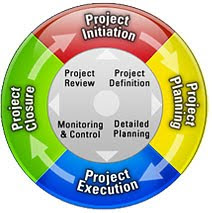Task for this week - comlepletion and submission of Tutorial 2.With the completion identifying the project objectives and scope in terms of costs, duration, responsibility, and etc..this week we are looking into the work breakdown structure (WBS) and mind-mapping of the project objectives and this will lead to the tasks and responsibility that every team members have to focus on.
What is WBS? WBS is ...is work breakdown structure in project management, is a tool used to define and group a project's work discrete elements or tasks in a way that help organize and define the total work scope of the project (source: wikipedia).
From the WBS, we convert it into a mind-mapping concept by using the application of free web-based mapping tool,
http://www.mindmeister.com/.
Here is the example of mind-mapping that we have done in class.

The psychologists say our brains can normally comprehend around 7-9 items simultaneously. A project with thousands or even dozens of tasks goes way over our ability to grasp all at once. The solution is to divide and conquer. The WBS helps break thousands of tasks into chunks that we can understand and assimilate. Preparing and understanding a WBS for your project is a big step towards managing and mastering its inherent complexity.
The WBS is commonly used at the beginning of a project for defining project scope, organizing Gantt schedules and estimating costs. It lives on, throughout the project, in the project schedule and often is the main path for reporting project costs.
WBS design should try to achieve certain goals:
1. Be compatible with how the work will be done and how costs and schedules will be managed,
2. Give visibility to important or risky work efforts,
3. Allow mapping of requirements, plans, testing, and deliverables,
4. Foster clear ownership by managers and task leaders,
5. Provide data for performance measurement and historical databases, and
6. Make sense to the workers and accountants.
Reflection:This week we learnt a lot about project. To be truth, this is the first time that our team members really heard of the work WBS, except for our leader Boo Wei Chong as he is an engineer which involved a lot in project management at his work place. Aside from WBS, we are also exposed to new knowledge of doing a gantt chart using Microsoft Project Solver.
We had a lot of fun adding the various pictures and icons as well as struggled with the various functions and keys necessary to set up the gantt chart correctly to reflect our project. As 3 of us in the group do not have Microsoft Project Solver in our offices or personal computers, we had to depend on our leader Wei-Chong to do this gantt chart. However, it was not easy as he only had this program in his office.
In the end, one of our team members, Regina, managed to get hold of this Microsoft Project Solver, from her sister's laptop and we could now do it at our own time during the weekend. It was a mad rush, but we managed to meet up and discuss the criterias, managed the basic workings of this program and finally came up with the gantt chart. It was real challenging ! Phew....










